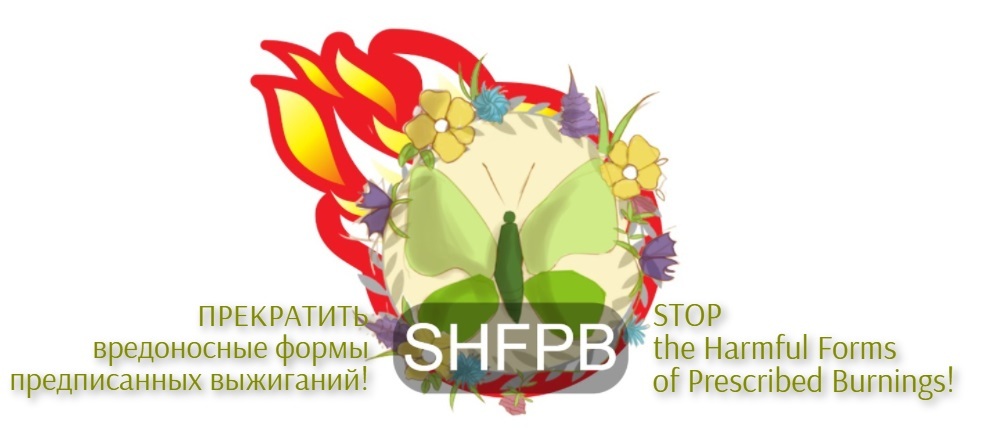РУС ENGL

Preamble
The position of the international public campaign “Stop the Harmful Forms of Prescribed Burnings!”
The campaign is conducted on behalf of the International Socio-Ecological Union, ISEU (Международный Социально-экологический Союз) – the international public environmental organization and expert community, created in the Russian Federation in 1988.
The purpose of the campaign is to voice and put on the world agenda a set of problems caused by the catastrophic negative consequences of the harmful forms of prescribed burning for biodiversity, natural ecosystems, climate, soils, natural waters, human health and the economy. Discuss these problems at the national and international levels, elaborate solutions to them, and start implementation of these solutions.
a. The problem of loss of biodiversity, destruction of functionality and degradation of natural ecosystems.
Prescribed burnings destroy the habitats of a huge variety of organisms that live in the grass cover, plant litter, rotting wood and topsoil of natural territories. Most of the organisms living in these tiers of ecosystems die from fire or as a result of the destruction of their habitat with each burning operation. If burnings are conducted regularly (and if the interval between burnings is less than a natural interval between wildfires inherent to the territory), then they can lead to the loss of more than 98% of the biodiversity of the burnt natural areas, destruction of functionality and degradation of their ecosystems. In particular, the process of decomposition of dead organic matter in the ecosystem may slow down or completely stop.
b. The problem of soil degradation and pollution.
Due to prescribed burning of plant litter and grass cover, soil biota dies, humus and dead organic matter accumulated in soils are partially burned down. This action should inevitably lead to a violation of the process of soil formation and soil degradation. The use of chemicals in large-scale prescribed burning operations inside natural areas inevitably leads to the soil pollution.
c. The problem of degradation of freshwater ecosystems.
Prescribed burning negatively affects freshwater ecosystems by chemical contamination of water, changes in water acidity, increase of water temperature, siltation of reservoirs and other consequences. This can lead to degradation of aquatic ecosystems, including reduction in the diversity and abundance of aquatic and near-aquatic fauna.
d. The problem of exacerbation of global and local climate change.
A large amount of soot produced by prescribed burnings is transferred with air mass and deposited on the glaciers of the Arctic and Antarctic regions as well as on mountain glaciers, which should cause their melting. The melting of glaciers should exacerbate global and local climate change. The carbon dioxide emissions into the atmosphere produced by artificial burning also aggravate the problem of global climate change. Without artificial burning, a plant litter decomposes by detritophages and turns into the soil.
e. The problem of the growth of wildfires due to direct and indirect factors of the negative influence of prescribed burning.
Different data allow to suggest that prescribed burnings do not help to prevent severe wildfires, but have exactly the opposite effect, they lead to increase of frequency and area of strong wildfires.
f. The problem of pollution of the environment by chemicals and products of burning and harm this to people health.
The large-scale prescribed burnings are often conducted by dint of chemicals which pollute the environment and negatively affect the health of the local people.
The position of the campaign describes these problems and the causes of their occurrence, which have become a consequence of the long-term practice of intentional burning used in many countries of the world.
The position of the campaign has three parts.
PART I. INTRODUCTION TO THE PRESCRIBED BURNING PROBLEM
We consider the negative characteristics of the prescribed burning industry in the world and their probable destructive consequences for biodiversity, natural ecosystems, climate, soils, natural waters, human health, and the economy. We give our definition of the “harmful forms” of prescribed burning. We explain why the harmful forms of prescribed burning should be considered as a phenomenon of intentional, large-scale, long-term ECOCIDE. We also explain why the practice of prescribed burning can lead to increase of the scale of severe wildfires (not to decrease in these scales).
PART II. THE OBJECTIVES AND PROPOSALS OF THE CAMPAIGN
We consider what steps should be implemented to start a solution of the complex of hard problems caused by prescribed burning industry around the world.
PART III. ANALYSIS OF MISCONCEPTIONS IN THE FUNDAMENT OF THE SCIENTIFIC AND PRACTICAL PARADIGM OF PRESCRIBED BURNING
We consider the erroneous concepts underlying the scientific and practical paradigm of prescribed burning. Under the paradigm we understand the scientific theory and practice, the industry of propaganda and dissemination of prescribed burns. By concept we mean statements and ideas, as well as the related terms and techniques of the prescribed burning paradigm.
The full text of the position can be uploaded by the following links:
The position can be modified, but it will always be possible to upload the latest version of it using the links above. The newest date is indicated on the first page of the documents.